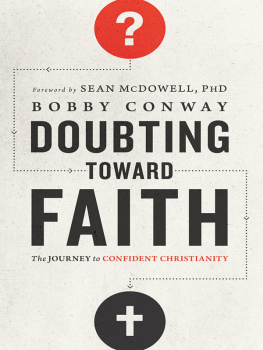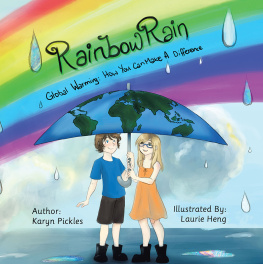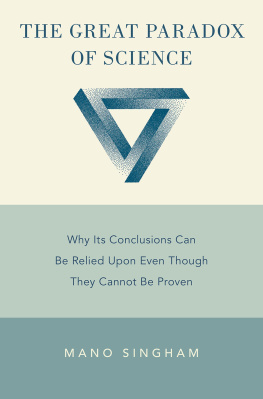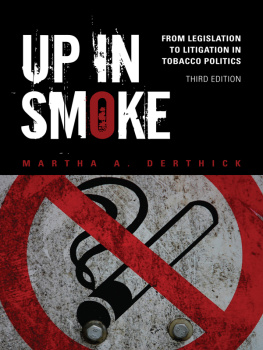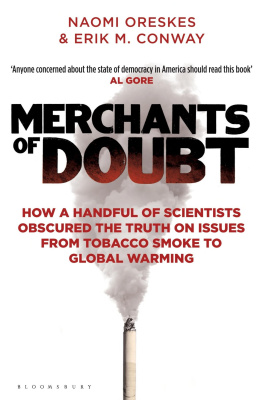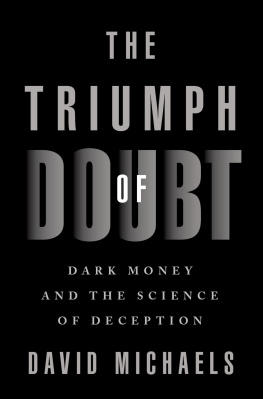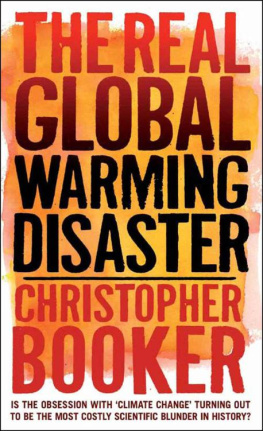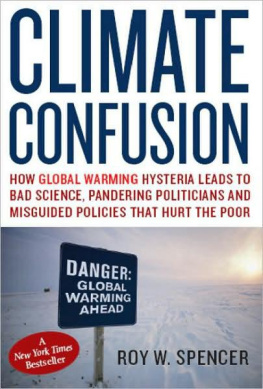MERCHANTS OF DOUBT
How a Handful of Scientists
Obscured the Truth on Issues from
Tobacco Smoke to Global Warming
NAOMI ORESKES
and
ERIK M. CONWAY

First published in Great Britain in 2011
Copyright 2010 by Naomi Oreskes and Erik M. Conway
This electronic edition published in 2011 by Bloomsbury Publishing Plc
Bloomsbury Publishing, London, New York, Berlin and Sydney
The moral rights of the authors have been asserted
No part of this book may be used or reproduced in any manner whatsoever without written permission from the Publisher except in the case of brief quotation embodied in critical articles or reviews
All rights reserved You may not copy, distribute, transmit, reproduce or otherwise make available this publication (or any part of it) in any form, or by any means (including without limitation electronic, digital, optical, mechanical, photocopying, printing, recording or otherwise), without the prior written permission of the publisher. Any person who does any unauthorised act in relation to this publication may be liable to criminal prosecution and civil claims for damages
Bloomsbury Publishing Plc, 50 Bedford Square, London, WC1B 3DP
A CIP catalogue record for this book is available from the British Library
eISBN 978 1 4088 2877 9
www.bloomsbury.com
Visit www.bloomsbury.com to find out more about our authors and their books You will find extracts, author interviews, author events and you can sign up for newsletters to be the first to hear about our latest releases and special offers
To Hannah and Clara
Its in your hands now.
This generation has altered the composition of the atmosphere on a global scale through a steady increase in carbon dioxide from the burning of fossil fuels.
LYNDON JOHNSON
SPECIAL MESSAGE TO CONGRESS, 1965
The trouble with Americans is that they havent read the minutes of the previous meeting.
ADLAI STEVENSON
Contents
Ben Santer is the kind of guy you could never imagine anyone attacking. Hes thoroughly moderateof moderate height and build, of moderate temperament, of moderate political persuasions. He is also very modestsoft-spoken, almost self-effacingand from the small size and nonexistent dcor of his office at the Lawrence Livermore National Laboratory, you might think he was an accountant. If you met him in a room with a lot of other people, you might not even notice him.
But Santer is no accountant, and the world has noticed him.
Hes one of the worlds most distinguished scientiststhe recipient of a 1998 MacArthur genius award and numerous prizes and distinctions from his employerthe U.S. Department of Energybecause he has done more than just about anyone to prove the human causes of global warming. Ever since his graduate work in the mid-1980s, he has been trying to understand how the Earths climate works, and whether we can say for sure that human activities are changing it. He has shown that the answer to that question is yes.
Santer is an atmospheric scientist at the Lawrence Livermore National Laboratorys Model Diagnosis and Intercomparison Project, an enormous international project to store the results of climate models from around the globe, distribute them to other researchers, and compare the models, both with real-world data and with each other. Over the past twenty years, he and his colleagues have shown that our planet is warmingand in just the way you would expect if greenhouse gases were the cause.
Santers work is called fingerprintingbecause natural climate variation leaves different patterns and traces than warming caused by greenhouse gases. Santer looks for these fingerprints. The most important one involves two parts of our atmosphere: the troposphere, the warm blanket closest to the Earths surface, and the stratosphere, the thinner, colder part above it. Physics tells us that if the Sun were causing global warmingas some skeptics continue to insistwed expect both the troposphere and the stratosphere to warm, as heat comes into the atmosphere from outer space. But if the warming is caused by greenhouse gases emitted at the surface and largely trapped in the lower atmosphere, then we expect the troposphere to warm, but the stratosphere to cool.
Santer and his colleagues have shown that the troposphere is warming and the stratosphere is cooling. In fact, because the boundary between these two atmospheric layers is in part defined by temperature, that boundary is now moving upward. In other words, the whole structure of our atmosphere is changing. These results are impossible to explain if the Sun were the culprit. It shows that the changes we are seeing in our climate are not natural.
The distinction between the troposphere and the stratosphere became part of the Supreme Court hearing in the case of Massachusetts et al. v. the EPA, in which twelve states sued the federal government for failing to regulate carbon dioxide as a pollutant under the Clean Air Act. Justice Antonin Scalia dissented, arguing that there was nothing in the law to require the EPA to actbut the honorable justice also got lost in the science, at one point referring to the stratosphere when he meant the troposphere. A lawyer for Massachusetts replied, Respectfully, Your Honor. It is not the stratosphere. Its the troposphere. The justice answered, Troposphere, whatever. I told you before Im not a scientist. Thats why I dont want to deal with global warming.
But we all have to deal with global warming, whether we like it or not, and some people have been resisting this conclusion for a long time. In fact, some people have been attacking not just the message, but the messenger. Ever since scientists first began to explain the evidence that our climate was warmingand that human activities were probably to blamepeople have been questioning the data, doubting the evidence, and attacking the scientists who collect and explain it. And no one has been more brutallyor more unfairlyattacked than Ben Santer.
THE INTERGOVERNMENTAL PANEL on Climate Change (IPCC) is the worlds leading authority on climate issues. Established in 1988 by the World Meteorological Organization and the United Nations Environment Program, it was created in response to early warnings about global warming. Scientists had known for a long time that increased greenhouse gases from burning fossil fuels could cause climate changethey had explained this to Lyndon Johnson in 1965but most thought that changes were far off in the future. It wasnt until the 1980s that scientists started to worryto think that the future was perhaps almost hereand a few mavericks began to argue that anthropogenic climate change was actually already under way. So the IPCC was created to evaluate the evidence and consider what the impacts would be if the mavericks were right.
In 1995, the IPCC declared that the human impact on climate was now discernible. This wasnt just a few individuals; by 1995 the IPCC had grown to include several hundred climate scientists from around the world. But how did they know that changes were under way, and how did they know they were caused by us? Those crucial questions were answered in Climate Change 1995: The Science of Climate Change, the Second Assessment Report issued by the IPCC. Chapter 8 of this report, Detection of Climate Change and Attribution of Causes, summarized the evidence that global warming really was caused by greenhouse gases. Its author was Ben Santer.




